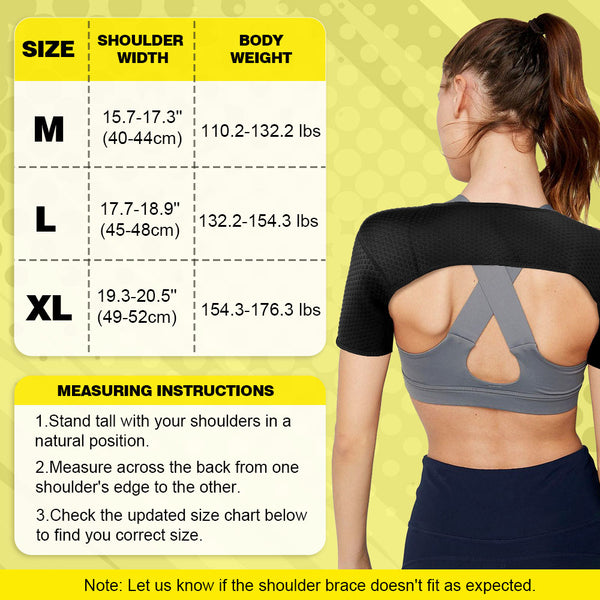Should You Sleep with a Double Shoulder Brace On

can support shoulders and avoid unconscious pressures. It is applicable for acute injuries, but choosing an appropriate size has to be considered in order not to cause tightness and long-term reliance to avoid muscle dependence, affecting recovery.
Why Use It
The is usually worn to, primarily, support the shoulder joints and muscles in cases of injury to the shoulders, tears in the rotator cuff, instability of the joints, and overuse. Since there are so many shoulder problems, sleeping positions at night make them painful, so the double shoulder brace supports the shoulder to avoid unwanted movement or additional stress on the joint.
Many who suffer from shoulder injuries find it great to wear a brace during the day; however, they have a tendency to lean on or twist their shoulder while sleeping, increasing the pain. A double shoulder brace would offer added support through the night, helping to keep the shoulder stable through recovery and easing night pain. Such design also suits athletes that need long-term recovery or individuals who have work habits that stress the shoulder area. This could, to some extent, help relieve pain and afford a better opportunity for the body to cure itself.
This is not to say that a brace should not be used, though one is not indicted in all situations. Certainly it is well understood that a brace used over a long period of time can weaken the shoulder through dependence by the shoulder muscles and joints on the device. Ideally it is best seen by a doctor or a physical therapist beforehand to ensure that its use is indicated for your particular condition.
Pros & Cons
A double shoulder brace does help in and relieving pain, but there are pros and cons with this.
The major benefit of wearing a brace would be that it stabilizes the shoulder, allowing very minimal stretching of the muscles or joint movement at night, thus preventing further injury. Precisely, during the acute stage, a brace will provide the needed rest for the shoulder without one placing unintended pressure on the shoulder while sleeping. Also, this can help in reducing nighttime pain and thus improves the quality of sleep.
However, there are disadvantages, too. First and foremost, to be blunt, sleeping can be a bit uncomfortable, especially if the material does not breathe or is restrictive in nature; this could lead to discomfort when one is turning over or when one starts to sweat excessively at night. Long-term use of a brace may make the muscles of the shoulders rigid and hence weaken them. Too much immobilization decreases shoulder mobility that might affect later recovery. Therefore, without doctor recommendation for long-term wear of braces, it would not be appropriate to do so.
When weighing the advantages and disadvantages of using a double shoulder brace, remember your specific shoulder condition. Generally speaking, no great risk may be involved in short-term use, but dependence on a brace for a very long time will bring about more side effects.

Comfort Tips
Comfort is the most important thing when sleeping with a double shoulder brace; though comfort cannot be highly expected from the brace, as it is designed mostly for support rather than comfort. Below are ways to help you sleep more comfortably while putting on a brace.
First, it should be adequately fitted; could affect comfort either way. A very tight brace could compress the nerves and vessels around the shoulder, leading to numbness or discomfort, while a too-loose one might not effectively support and could shift during the night, losing its protective effect.
In fact, if one has to wear the brace, then soft pajamas can be worn to minimize friction between the skin and the brace. A breathable cotton or slightly stretchy material is ideal because it could minimize the skin pressure feeling. You can also put a thin layer of fabric like medical gauze under the brace to add some cushioning to prevent skin irritation.
Try to keep the temperature of the room a little cool. Since the brace is going to make your body hotter, a cooler room setting can avoid that stuffy feeling, hence helping you sleep more easily. If the brace makes your shoulder feel tight, then give your shoulder a short break by not wearing it every couple of days. This will help it relax and not be compressed for too long.
How to Adjust
for a double shoulder brace will increase its comfort while making sure it is effective in providing support. Most double shoulder braces are fitted with adjustable shoulder and waist straps that help you adjust in regard to your size of shoulder, posture, and comfort.
Fasten first the principal strap of the brace on your shoulder, ensuring that it is correctly positioned upon the shoulder joint. The shoulder strap should be firm but without being too tight to avoid blood circulation impingement. Once the shoulder strap has been fastened, adjust either the side or front chest straps to securely fasten the brace at the shoulder without making breathing labored or pressure at the shoulder.
Move the waist strap to an equally tensioned position with the shoulder strap. The waist strap should not be too tight to prevent the constriction of circulation in case of a turn-over. The general placement of the brace should position the shoulder in such a way that it assumes a comfortable and natural position, without having the shoulder unnaturally or forcefully leaning forward or backward, so that stable support is maintained during nighttime.
Periodically check the tightness and support of the brace. With time, a brace might slightly loosen, especially when it needs to be used over a long period. Adjustments during the day can make it effective at night.

Sleep Positions
Wearing a double shoulder brace can make sleeping a bit cumbersome, and choosing a comfortable sleeping position is quite crucial as it provides lesser discomfort and possibly more protection to the shoulder. It has been generally said that sleeping on your back is usually the best position recommended, since it relieves all kinds of pressure off of the shoulder and permits the brace itself to provide protection.
If lying on your back hurts, you may sleep on your side, but avoid sleeping on the . During side sleeping, put pillows on both sides of the body to stop yourself from rolling onto the shoulder while you sleep. You may also use a pillow placed in front of your chest, which will further prevent sinking of the shoulder while sleeping on the side.
Avoid sleeping on your stomach because this increases the pressure on your shoulder in a forward direction, which decreases the good support provided by the brace. It also puts extra pressure on your shoulder when you sleep on your stomach, which could be one of the ways extra pain and stiffness is experienced each morning.
Sleeping on your back will be optimum, with side sleeping the next best alternative. This will provide variations of comfort for resting at night in the orthosis.
When to Avoid
However, while a double shoulder brace can be helpful at times, it should not always be necessary or suitable for instance. Here are situations when you may wish to avoid using the brace:
-
Because the shoulder is mostly healed or the pain has reduced, or when one has stayed in a brace for a long period, it may develop and hence hinders the natural recovery of the shoulder. The body now needs to gradually get back its range of motion and muscle strength, which excessive immobilization would prevent.
-
In this case, if for some reason it is not possible to sufficiently breathe through the material or design of the brace and the patient ends up with too much night-time sweating or skin discomfort, then it is better not to wear it during such a period. Friction from nighttime braces sometimes may cause rashes or irritation; thus, one can change to more breathing types or decrease wear time during recovery.
-
If you feel uncomfortable or the pain is worse with the brace on, don't wear it. The design for the brace is to protect the shoulder. If it feels worse, it could be that you are wearing it wrong or that it is not for you. Take a break and back to the doctor.
Protection and recovery needs must be balanced regarding the use of a brace. Consult a professional if you're not sure whether you need one.

Expert Advice
For most conditions, doctors and therapists recommend a double shoulder brace for flexible use. While the brace protects the shoulder during its recovery, it does not replace the recovery of the muscle strength. Normally, experts advise the use of the brace when the injury is in its acute phase to avoid unnecessary movement of the joints. You are supposed to gradually reduce the use of the brace when the pain decreases or the joint is stable to allow muscles and joints to recover independently.
Bracing should be done in conjunction with rehabilitation training, which includes exercises to improve shoulder flexibility and strength. Only when muscles and joints have good strength and stability will they be able to help with a reduction in re-injury. In fact, professionals suggest periodic follow-up visits to adjust the recovery plan accordingly, such as reducing the frequency of using the brace or increasing the range of motion of the shoulder.
Experts say the good brace is that which is of breathable materials and is able to adjust for comfort. The patients of chronic conditions or those who have long-standing shoulder discomfort are recommended to change the brace after certain periods in order for one not to get too dependent on it-the brace is supporting one to help him or her in the process of healing and not something on which one should depend forever
-
Posted in
Brace, Recovery, Shoulder pain













